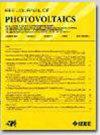热加速老化下光伏封装材料的交联、降解和粘附行为研究
IF 2.6
3区 工程技术
Q3 ENERGY & FUELS
引用次数: 0
摘要
光伏(PV)组件密封剂特性的退化导致机械脆化和分层仍然是太阳能装置失败的一个原因。先前发表了一个多尺度可靠性模型,将密封剂的力学和断裂性能与降解的分子结构以及与相邻太阳能电池和玻璃基板的界面结合联系起来。该模型主要用于聚(乙烯-醋酸乙烯)醋酸酯(EVA)密封剂,仍有待实验验证。确定替代封装剂的降解和交联动力学,如聚烯烃弹性体(POE)和EVA/POE/EVA复合材料(EPE),可以推广该模型。在这项工作中,我们将完全固化的EVA, POE和EPE密封剂进行加速热老化,以确定高温如何影响反应动力学。在热好氧(90℃,22% RH)和热厌氧(90℃,密封在N2空气中)老化条件下,即使在没有紫外线和交联引发剂的情况下,也观察到凝胶含量(交联)的增加和结晶度的降低。傅里叶变换红外光谱(FTIR)-衰减全反射分析显示封装剂降解不明显,表明紫外线和水分在加速降解中起关键作用。粘附测试显示,在5000小时的热干(90°C, ~ 1% RH)和湿热(90°C, 60% RH)老化过程中,粘附能(Gc)下降。POE券表现出最好的稳定性,其次是EPE,然后是EVA。对于EVA和POE,湿热老化券由于水解降解增强,Gc降低幅度较大。热干老化条件表明,即使封装剂在没有紫外线和高湿度的情况下经历可忽略的降解,界面的热降解也可能是显著的。本文章由计算机程序翻译,如有差异,请以英文原文为准。
Investigating the Crosslinking, Degradation, and Adhesion Behavior of Photovoltaic Encapsulants Under Thermal Accelerated Aging
Degradation of photovoltaic (PV) module encapsulant characteristics that lead to mechanical embrittlement and delamination remains a cause of failure in solar installations. A multiscale reliability model connecting the encapsulant mechanical and fracture properties to the degraded molecular structure and interfacial bonding to adjacent solar cell and glass substrates was previously published. The model, developed primarily for poly(ethylene-co-vinyl acetate) acetate (EVA) encapsulants, remains to be experimentally validated. Determining the degradation and crosslinking kinetics of alternative encapsulants, such as polyolefin elastomer (POE) and EVA/POE/EVA composites (EPE), can generalize the model. In this work, we subject fully cured EVA, POE, and EPE encapsulants to accelerated thermal aging to determine how high temperatures impact reaction kinetics. An increase in gel content (crosslinking) and decrease in crystallinity of the encapsulants under hot-aerobic (90 °C, 22% RH) and hot-anaerobic (90 °C, sealed in N2 air) aging were observed, even in the absence of UV and crosslinking initiators. Fourier transform infrared spectroscopy (FTIR)-attenuated total reflectance analysis showed insignificant encapsulant degradation, demonstrating the critical role of UV and moisture in accelerating degradation. Adhesion testing performed on coupon-level specimens (cell/encapsulant/glass laminates) showed decreases in adhesion energy, Gc, from 5000 h of hot-dry (90 °C, ∼1% RH) and hot-humid (90 °C, 60% RH) aging. POE coupons demonstrated the best stability, followed by EPE then EVA. For EVA and POE, hot-humid aged coupons experienced a larger decrease in Gc due to enhanced hydrolytic degradation. Hot-dry aging condition demonstrated that thermal degradation of the interface could be significant even if the encapsulant experiences negligible degradation in the absence of UV and elevated humidity.
求助全文
通过发布文献求助,成功后即可免费获取论文全文。
去求助
来源期刊

IEEE Journal of Photovoltaics
ENERGY & FUELS-MATERIALS SCIENCE, MULTIDISCIPLINARY
CiteScore
7.00
自引率
10.00%
发文量
206
期刊介绍:
The IEEE Journal of Photovoltaics is a peer-reviewed, archival publication reporting original and significant research results that advance the field of photovoltaics (PV). The PV field is diverse in its science base ranging from semiconductor and PV device physics to optics and the materials sciences. The journal publishes articles that connect this science base to PV science and technology. The intent is to publish original research results that are of primary interest to the photovoltaic specialist. The scope of the IEEE J. Photovoltaics incorporates: fundamentals and new concepts of PV conversion, including those based on nanostructured materials, low-dimensional physics, multiple charge generation, up/down converters, thermophotovoltaics, hot-carrier effects, plasmonics, metamorphic materials, luminescent concentrators, and rectennas; Si-based PV, including new cell designs, crystalline and non-crystalline Si, passivation, characterization and Si crystal growth; polycrystalline, amorphous and crystalline thin-film solar cell materials, including PV structures and solar cells based on II-VI, chalcopyrite, Si and other thin film absorbers; III-V PV materials, heterostructures, multijunction devices and concentrator PV; optics for light trapping, reflection control and concentration; organic PV including polymer, hybrid and dye sensitized solar cells; space PV including cell materials and PV devices, defects and reliability, environmental effects and protective materials; PV modeling and characterization methods; and other aspects of PV, including modules, power conditioning, inverters, balance-of-systems components, monitoring, analyses and simulations, and supporting PV module standards and measurements. Tutorial and review papers on these subjects are also published and occasionally special issues are published to treat particular areas in more depth and breadth.
 求助内容:
求助内容: 应助结果提醒方式:
应助结果提醒方式:


